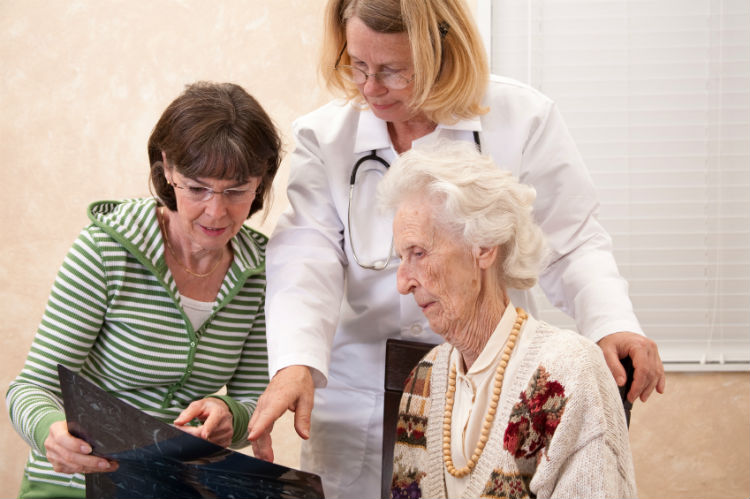A care plan is a tool that long-term care providers use to coordinate and manage patients’ health care goals, needs, and services. Family caregivers can also benefit from using this strategy for providing care, but this is a tool that must be regularly evaluated and updated to continue being effective. Once an initial care plan has been established, all aspects of it should be reviewed periodically—especially after certain health events.
Read: How to Create a Personalized Care Plan
How Often Should Care Plans be Updated?
Care plans are constantly evolving. The frequency of evaluation depends largely on the nature of a care recipient’s medical conditions and the level of assistance they require. For example, someone with a progressive condition like chronic obstructive pulmonary disease (COPD) or Alzheimer’s disease will likely need more frequent assessments than an individual with milder or more stable health issues.
As a point of reference, Medicare requires home health agencies to review each client’s care plan at least once every 60 days. In Medicare-certified nursing homes, full health assessments and appropriate care plan updates must be made at least once every 90 days. Both these examples focus on patients with fairly complex medical conditions and care needs, but attention to detail is crucial, even for older adults who are still fairly healthy and independent.
Identify Important Changes
Picking up on even subtle changes in how a senior is feeling, both physically and mentally, is an ongoing part of providing high quality care. Start by talking with them and, most importantly, listening for any changes or complaints that seem to be new or more serious than usual. If your loved one isn’t forthcoming or able to able to convey how they’re feeling, you’ll need to rely on careful observation to detect changes in body language and behavior that may indicate things like pain, discomfort, or confusion.
Changes in any of the following symptoms should be discussed with their primary care physician immediately to make the appropriate changes to their care plan:
- Frequent urination or changes in bowel movements
- Itching, wounds, or new skin problems
- Changes in balance, coordination, or strength
- Indigestion or nausea
- Thirst, increased hunger, or loss of appetite
- Fever
- Drowsiness, fatigue, or insomnia
- Headaches or body aches
- Dizziness, restlessness, or a tendency to stumble or fall
- Changes in mental status
Ensuring Proper Post-Hospital Care
A visit to the emergency room, whether a senior is admitted to the hospital or not, is considered an important development in their condition. Care plans should always be assessed and updated following a hospitalization.
If a senior is admitted, a transitional care plan should be provided as part of the hospital discharge process. This plan will detail all new medications, prescribed medical equipment, such as mobility aids, any therapy needs, and orders for follow-up medical appointments. Be sure to add to or adapt their existing care plan to incorporate these important changes.
The discharge care plan could be as simple as adding an antibiotic to their medication regimen for 10 days to treat a UTI, or it could call for a short-term stay at a senior rehabilitation facility to help manage a new or worsening chronic condition. Carefully review this plan with a discharge coordinator at the hospital. They will help you decide if you are equipped to handle your loved one’s care on your own or if in-home care or a rehab stay will be necessary to meet their needs and assist in their recovery. If possible, involve your loved one in conversations with the doctor(s) so they understand that a return visit to the hospital may result if discharge instructions aren’t followed.
Schedule all follow-up appointments as soon as your loved one returns home, and make sure to get an appointment with their primary care physician (PCP) within two weeks of the hospital visit. The PCP should be familiar with your loved one’s health status and the various sources of support they receive. These details are crucial for coordinating a more permanent plan of care for treating and/or managing an older adult’s condition.
Setting New Health Goals
Sometimes changes to a care plan aren’t made because of a hospital visit or a change in health. Certain modifications can refresh a senior’s daily routine and provide preventative health benefits. Work with your loved one to set personal goals that will improve their physical and mental health as well as their overall quality of life.
Even small goals, such as walking to the mailbox or baking cookies, can be motivating short-term or long-term objectives. Incorporate daily activities that will help them tackle these ambitions. Minor advances can help a senior work up to more meaningful achievements. When older adults are active participants in their own health and well-being, they are usually able to remain independent and safe in their own homes for much longer.
Communicate with All Care Team Members
A comprehensive care plan usually requires a team of family members, friends, professionals, and community resources to be executed smoothly. Regular communication with all team members is essential. Each person brings a unique perspective and area of expertise to the table, and different people tend to pick up on things that others may miss. Interacting with a senior in various situations and at different times of day can also reveal a great deal about subtle changes in their health and functional abilities.
To ensure the current care plan is being followed, try making frequent check-in phone calls with other team members or keeping a log of daily observations and activities. These strategies can also keep everyone informed and make it easier to recognize patterns in behavior or symptoms that should be addressed.
Take time to find out how the person you’re caring for feels about their care routine, too. Let them know that they still have control over their day-to-day life and whom they spend it with. If there is a part of their routine that they aren’t fond of, or something they would like to add, work with them to make reasonable and realistic changes. The same goes for members of the care team. If a senior is not connecting with a particular team member or caregiver, don’t be afraid to make a change if you think there might be a better fit.
Prioritize Your Own Health and Happiness to Prevent Burnout
Care planning should benefit family caregivers, too. Each time you evaluate a loved one’s care plan and team, take inventory of how you are feeling mentally and physically. You may find that you’ve forgotten to schedule this year’s annual physical or that you’re feeling spread too thin. Set goals for your own daily routine and find ways to incorporate them into the plan. This will enable you to make time for self-care and prevent caregiver burnout.
Introducing outside help, such as in-home care or adult day care services, can give you a well-deserved break. Home care companies also devise and regularly update client care plans as part of their services. If you could use some extra support and assistance with coordinating care and responsibilities, in-home care is an excellent option.
Read: How to Select a Home Care Company
Be attentive to your loved one’s changing needs, factor yourself into this care plan, and take advantage of all the resources available to you through your friends, family and community.

